The War Zone continues to dig into the bizarre U.S. Navy patents authored by enigmatic inventor Dr. Salvatore Pais and the seemingly unusual circumstances of their approval by the U.S. Patent and Trademark Office (USPTO). As part of our investigation, we recently obtained a tranche of internal emails from Naval Air Systems Command, or NAVAIR, which appear to have been sent between Pais and personnel in different NAVAIR offices. While the Navy's exotic energy production patents remain as mysterious as ever, these emails add to the backstory surrounding the inventions of Salvatore Pais and suggest that the patents went through a more rigorous internal evaluation process than was previously known. The emails also seem to indicate that the research program that emanated from the patents did in fact result in an experimental demonstration of some sort.
Last year, the publication of several unusual patents assigned to the U.S. Navy raised eyebrows due to the seemingly radical and unconventional claims found within them. These patents included bizarre technologies such as a “high temperature superconductor,” a "high frequency gravitational wave generator," a force field-like "electromagnetic field generator," a “plasma compression fusion device,” and a hybrid aerospace/underwater craft featuring an "inertial mass reduction device." They truly sound like the stuff of science fiction and seem to describe the theoretical building blocks of a craft with UFO-like performance.
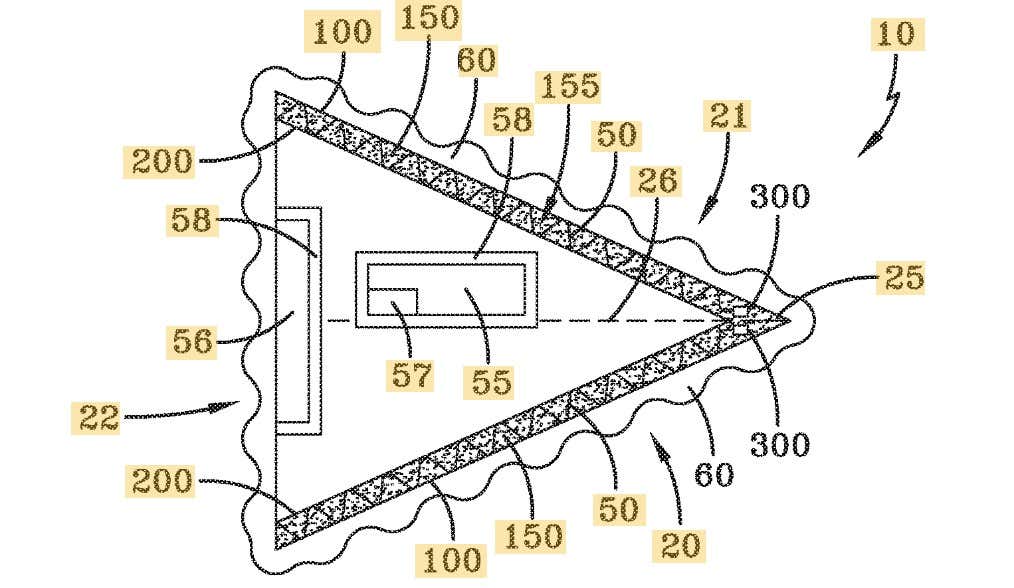
An image from Pais's "Craft Using an Inertial Mass Reduction Device" patent.Each of the Navy inventions are credited to one Dr. Salvatore Cezar Pais, who, at the time the patent applications were submitted, was an aerospace engineer at NAVAIR's Naval Air Warfare Center Aircraft Division (NAWCAD) in Patuxent (Pax) River, Maryland. Every one of Pais' recent inventions depends on what the inventor calls “the Pais Effect,” described in numerous publications by the inventor as the “controlled motion of electrically charged matter (from solid to plasma) via accelerated spin and/or accelerated vibration under rapid (yet smooth) acceleration-deceleration-acceleration transients.”
Internal NAWCAD And NAVAIR Emails Contain Additional Details
The internal NAVAIR emails The War Zone has recently obtained are all related to the creation of the patent application and internal review process for Pais’s seemingly bizarre “Craft Using an Inertial Mass Reduction Device” patent. All names within this release have been redacted, but it appears possible that many of the emails could have been written by Dr. Salvatore Pais based on portions of email signatures left unredacted, not to mention the fact that they describe Pais’s patents and publications in the first person. Still, it's ultimately impossible to be 100% certain that these emails were indeed written by Pais himself despite The War Zone referring to the author as Pais throughout this reporting for simplicity.
While much remains unknown about these patents and their provenance, these emails offer a few new details about the internal processes Pais and other NAWCAD employees at Pax River undertook in getting some of the patents approved. For one, these emails reveal that Pais made an additional $700 between 2016 and 2018 from two separate incentive awards for the “Craft Using An Inertial Mass Reduction Device” patent.
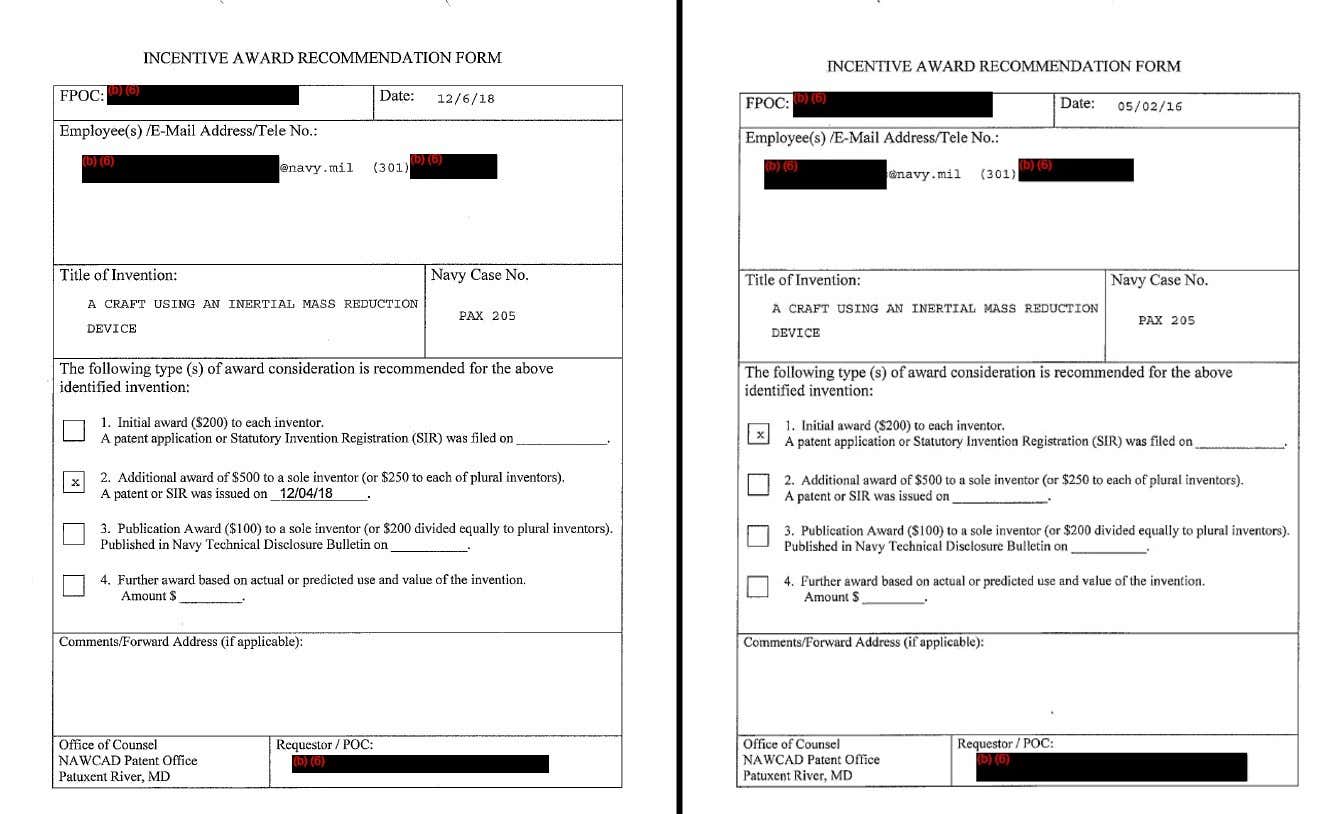
The emails largely discuss bureaucratic procedures and paperwork related to the invention disclosures and patent application processes. These emails include individuals from NAWCAD, including its Office of Counsel, as well as elsewhere within NAVAIR, such as the Naval Test Wing Atlantic, and at a drafting company in Uniontown, Ohio that was hired to illustrate the patent applications.
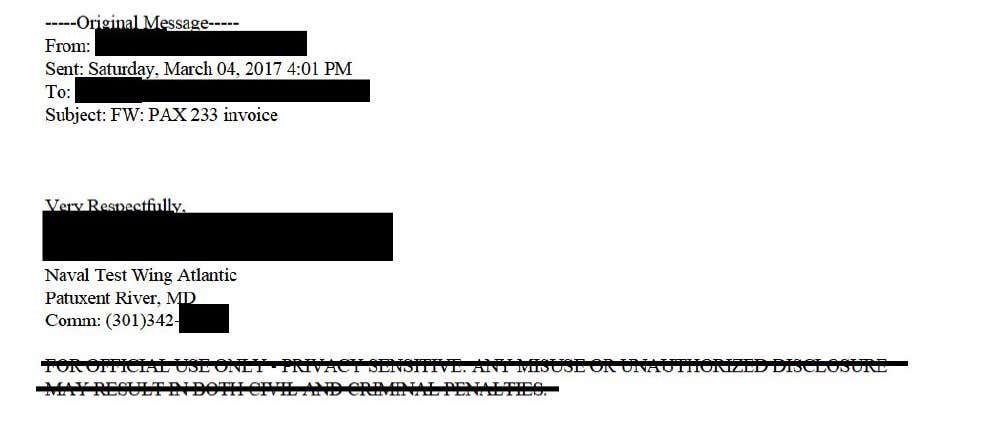
The invention disclosure forms contained in these releases show that Pais claims several of his patents - “Craft Using an Inertial Mass Reduction Device,” “Piezoelectricity-induced High Temperature Superconductor,” “High Frequency Gravitational Wave Generator,” and “Ultrahigh Intensity Electromagnetic Field Generator” - are all interrelated. The gravitational wave generator application was cited as a follow-up to both the electromagnetic wave generator application and the inertial mass reduction device application, and is also listed as a closely related patent in the high-temperature superconductor application.
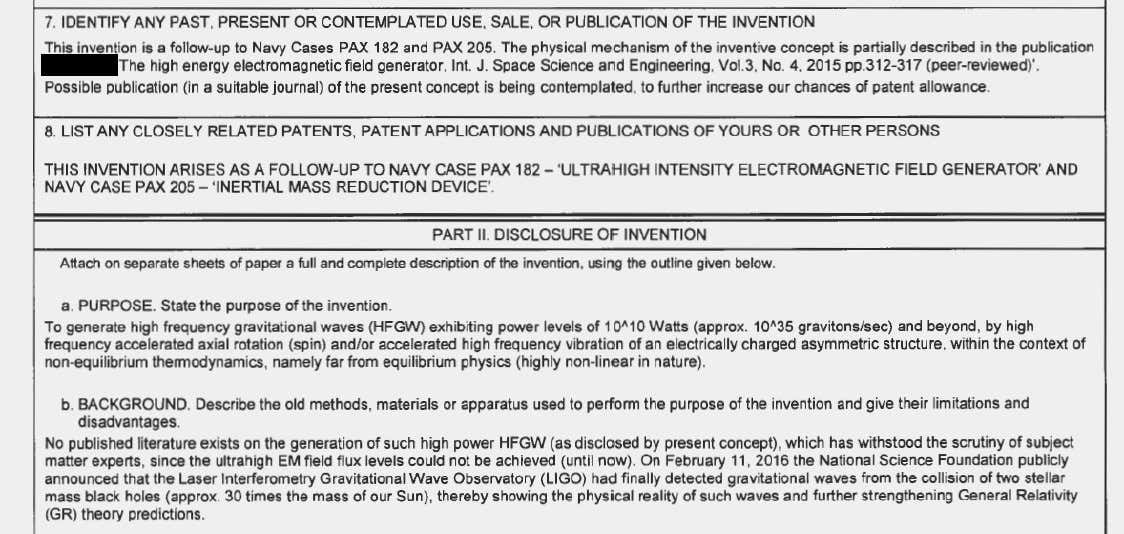
Disclosure form for the high-frequency gravitational wave generator.
All three of the invention disclosure forms (“Craft Using an Inertial Mass Reduction Device,” “Piezoelectricity-induced High Temperature Superconductor,” and “High Frequency Gravitational Wave Generator”) show that these inventions were disclosed to multiple employees at NAVAIR prior to application.
The emails also show that Pais’s inventions were reviewed by the Technology Transfer Office (TTO) at Pax River. According to the NAWCAD TTO Director’s LinkedIn profile, the mission of this office is to “strive to advance the mission of NAWCAD and enhance the economic well-being of the nation” and that it “promotes the use of NAWCAD laboratories and test facilities, develops strategic partnerships with external customers and partners, and commercializes intellectual property.”
Pais's inventions underwent “technical and marketing reviews” sometime in late 2015, after which Pais defended his inventions in front of the NAWCAD Invention Evaluation Board throughout 2016 and 2017. The inventions appear to have cleared this review process, as NAWCAD then subsequently submitted them individually to the USPTO for patent approval beginning in April 2016 with the "inertial mass reduction device" patent.
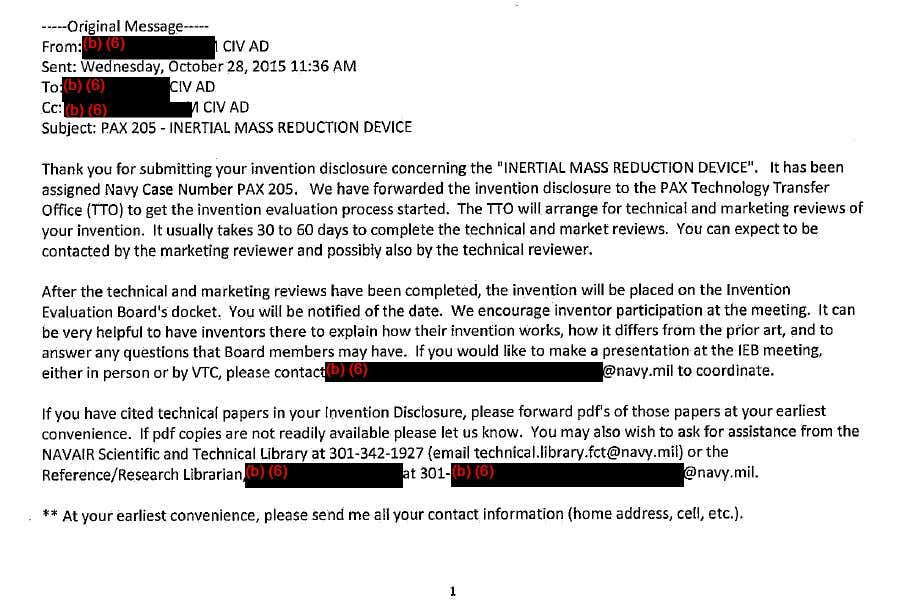
It was during the review period in late 2015 that the NAWCAD Office of Counsel cited U.S. Code of Federal Regulation 37 CFR § 501.6, which claims the Government has the right to any invention made by an employee during working hours, “with a contribution by the Government of facilities, equipment, materials, funds, or information,” or “which bears a direct relation to or is made in consequence of the official duties of the inventor.” NAWCAD was interested enough in Pais’s “Craft Using an Inertial Mass Reduction Device” patent to cite this code and claim the patents for the U.S. Government.
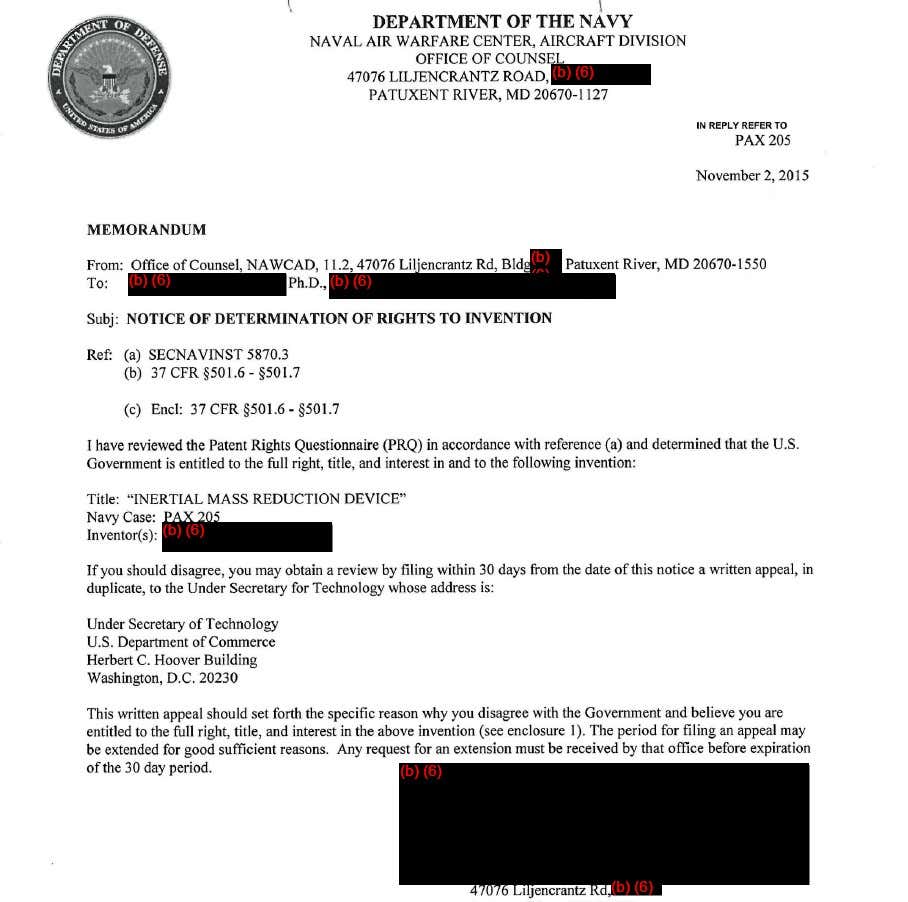
In his invention disclosure form for the inertial mass reduction device patent, Pais signed and dated a form reading “As the invention described herein was made as a direct result of the performance of my assigned duties, I hereby agree to assign the entire right, title and interest in the invention to the government and I understand that I will retain no rights in the invention.”
However, underneath Pais wrote that “There is no relationship whatsoever between my assigned duties and the invention. The invention was made independently of any job performance or assigned tasks by the Branch or Section.” He later wrote in the same disclosure form that “The entire Inventive Concept (Invention) and anything that pertains to it, was the inventor’s own work, with no government contribution whatsoever.”
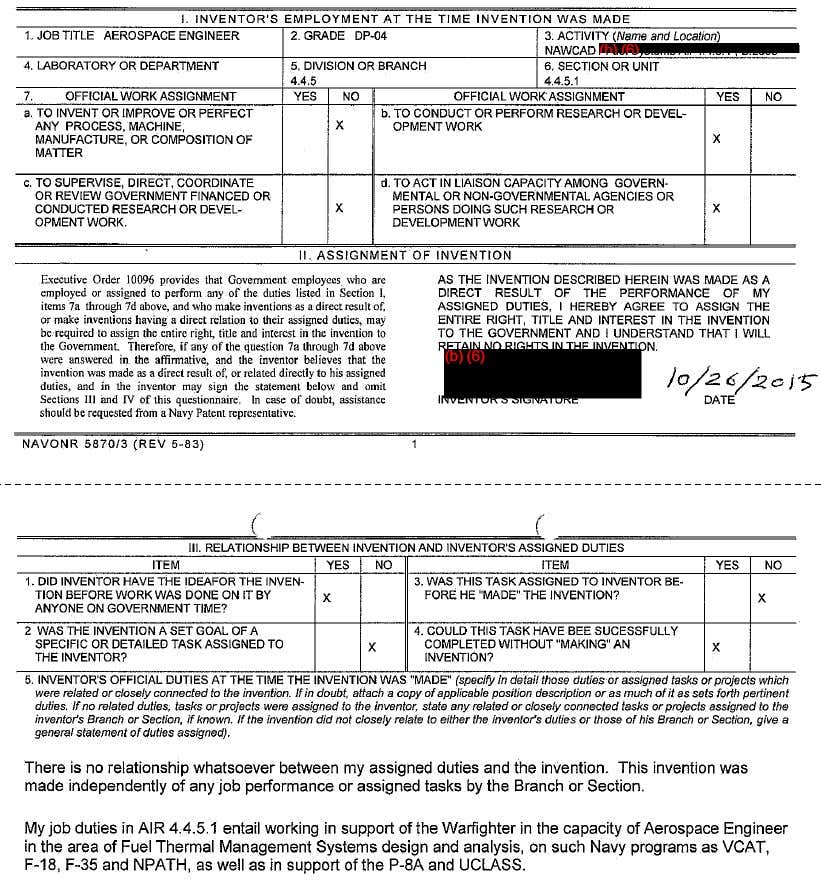
It’s curious that NAWCAD would cite 37 CFR § 501.6 and that Pais would sign and date a form stating the invention was made “made as a direct result of the performance of my assigned duties” yet just lines later also write that there was no relationship between his duties and the invention. The inventions were also evaluated by several internal NAWCAD/NAVAIR review boards and vouched for to the USPTO by NAWCAD leadership, despite apparently having no direct correlation to Pais's assigned duties.
Pais writes in the same form that his duties as an Aerospace Engineer for NAWCAD at the time included working in Fuel Thermal Management Systems design and analysis for aircraft such as the F-18, F-35, and P-8A, as well as working on programs such as the Naval Power, Avionics, and Thermal Laboratory (NPATH), Variable Cycle Advanced Technology (VCAT), and Unmanned Carrier-Launched Airborne Surveillance and Strike (UCLASS).
After one of his academic papers describing the patents was accepted for publication in 2016, Pais wrote in an email to several NAVAIR employees that “What is most unique about this paper is that it has already won the approval of Dr. [REDACTED], one of the world’s top authorities in Advanced Power and Propulsion/Quantum Vacuum Engineering, who has given his unreserved approval of this paper, calling it “a very good paper.” [REDACTED] has also forwarded the paper to several of his colleagues, including [REDACTED], another top subject matter expert.”
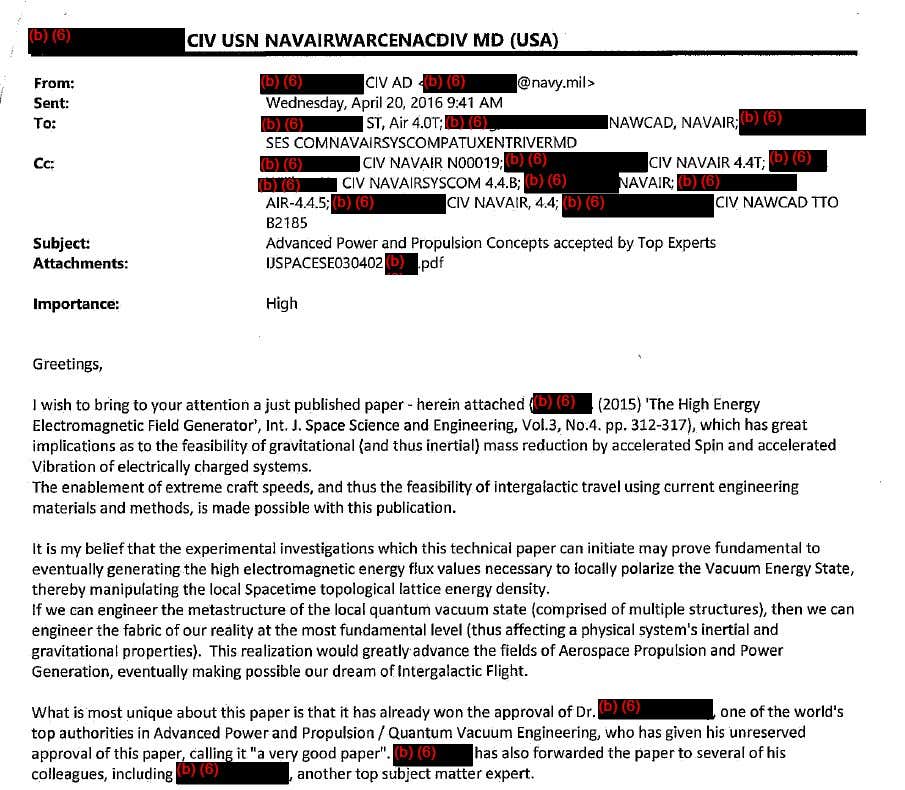
It’s unknown who the names redacted in this email may be, but there are a few likely candidates based on how small the fields of "Advanced Power and Propulsion" and "Quantum Vacuum Engineering" are. Works by two of the world’s authorities on the intersection of these topics, perennial ‘weird science’ contract stalwart Hal Puthoff and aerospace engineer H. David Froning, were included along with the patent application for Pais's "craft using an inertial mass reduction device" as “Non-Patent Literature Documents.”
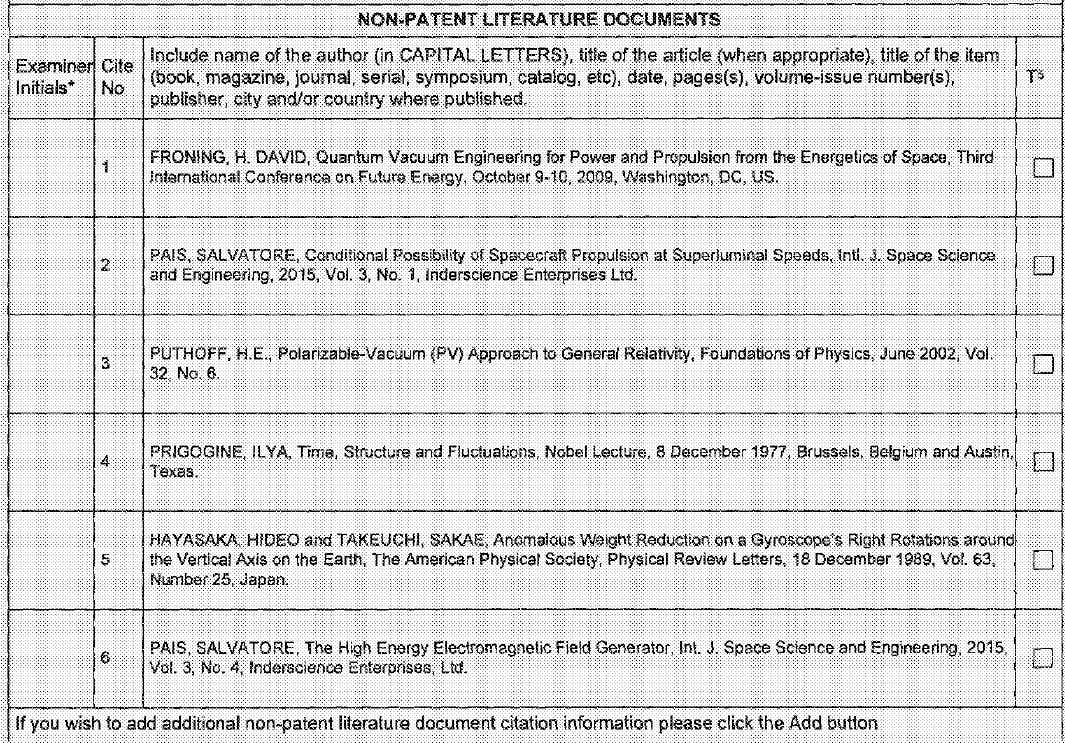
Froning has published extensive USAF-funded studies on hypersonic vehicle design and using directed energy to aid in aircraft propulsion. In addition, the Australian-based Froning has published peer-reviewed studies on “new directions in electromagnetism for propulsion and power” and using specially-conditioned electromagnetic fields to control nuclear fusion reactions - some of the same technologies patented by Pais on behalf of the U.S. Navy over the last several years.
Froning authored the 2016 book The Halcyon Years of Air and Space Flight: And the Continuing Quest, an examination of the “remaining barriers facing our next big steps in air and space” that offers examples of “material and energy systems and propulsion and flight systems that may be needed to overcome them.” Oddly enough, an Amazon user under the title "Salvatore Cezar Pais, Ph.D." appears to have left the book a glowing five-star Amazon review in mid-2016, and noted that the essence of the book is the development of "advanced field propulsion by the engineering of the quantum vacuum.” It's impossible to know if this book review was indeed written by Pais himself, although it's worth noting it was posted years before Pais's patents were made public, which thrust his name into the public eye.
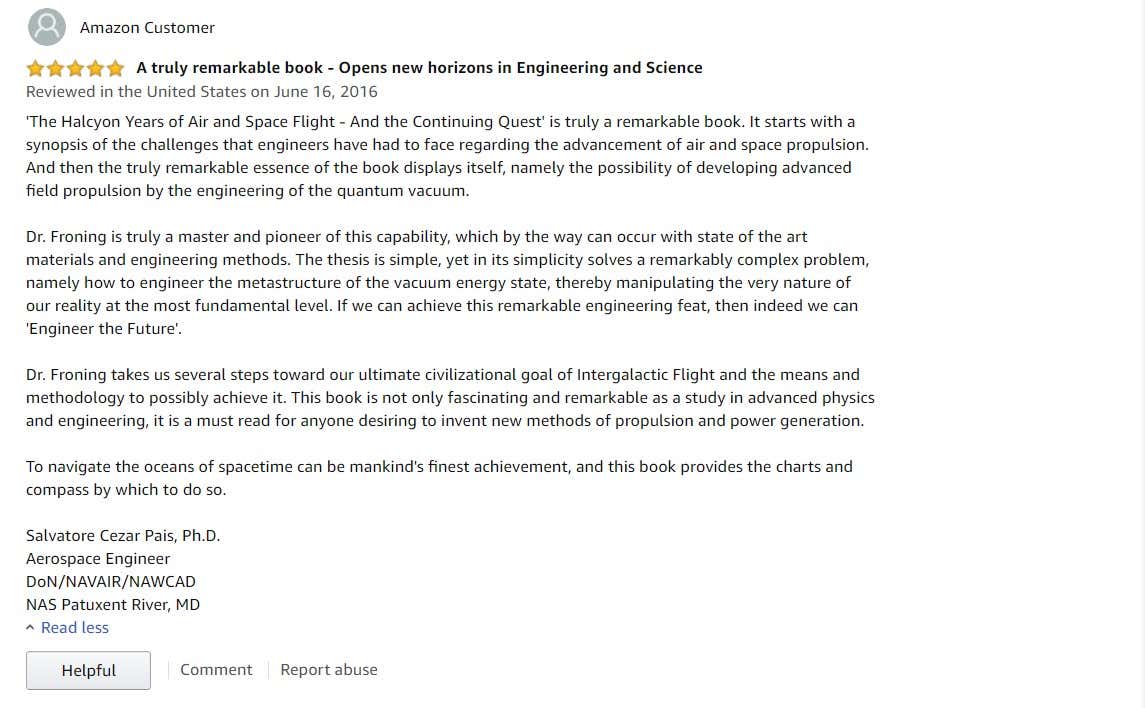
Ultimately, it’s unknown who the redacted subject matter experts in the email represent. Still, some of the language in the review of Froning’s book echoes the language in some of these internal NAVAIR emails. In the same email sent on April 20, 2016, Pais wrote to numerous NAVAIR employees that “the enablement of extreme craft speeds, and thus the feasibility of intergalactic travel using current engineering materials and methods, is made possible with this publication,” while this book review wrote that Froning's research "takes us several steps toward our ultimate civilizational goal of Intergalactic Flight" and "can occur with state of the art materials and engineering methods."
Pais closes the April 20, 2016 email by adding “One thing is for sure, the existence of this technical paper and its current acceptance by foremost authorities in the field will greatly facilitate the patent examination process, hopefully culminating in two essential patents for the technologically advanced future of the Navy.”

Nine days later, Pais wrote that the patent application had been filed with the USPTO, writing “[REDACTED] has done an admirable job and produced an exceptional patent application, [REDACTED] work is highly commendable. The inventive concept due to its simplicity and minimalism, despite its advanced quantum vacuum physics, pays homage to Occam’s Razor. Thank you Sir for your recommendation and your continued support.” It may be that Pais is referring Mark Glut, NAWCAD's patent attorney at the time of the patent application. As noted in our previous reporting, Glut was awarded power of attorney throughout the patent application process for the “Craft Using an Inertial Mass Reduction Device.”
In a May 2017 email, Pais writes that “[Redacted] is a formidable patent lawyer,” adding that “these advanced concepts were not easy to translate into easily understandable and technically admittable patent applications.” In the same email, Pais thanks the recipient for his “vision and leadership,” writing that “our discussions have generated many great ideas” and that Pais is “extremely grateful to you for understanding and backing them.”
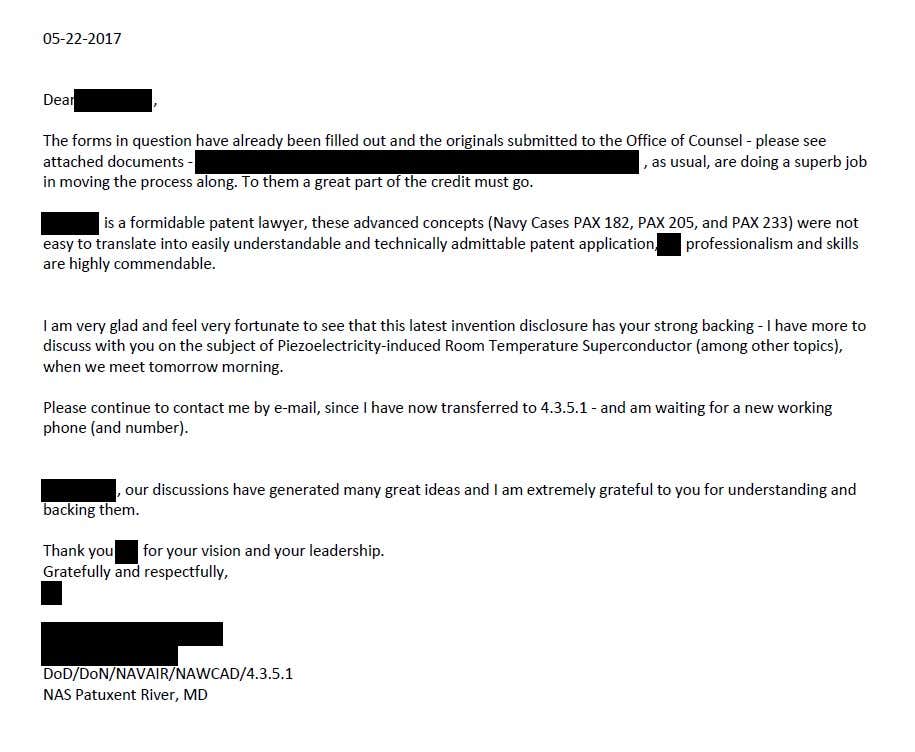
In our previous reporting on Pais’s patents, we noted that he has publicly thanked Naval Aviation Enterprise Chief Technology Officer Dr. James Sheehy in academic publications for his “many hours of thought-provoking discussions on the concept at hand.” In the emails related to the high-temperature superconductor patent, an unknown individual from the Naval Aviation Enterprise writes that “the concept has strong theoretical backing” and offers their help in the patent application process. As we have previously reported, Sheehy stepped in to write statements to the USPTO personally attesting to the operability and enablement of the concepts in Pais's inventions.

After the patent application for “Craft Using an Inertial Mass Reduction Device” was submitted, an unknown individual from the Naval Aviation Enterprise congratulated Pais, writing “Congratulations!! Now to build a small demo to put the theory into a demo. The sec 219 BAR/TT [Basic Applied Research/Technology Transfer] call is out - could be the genesis of a BAR/TT project.” It could be that this individual was Dr. Sheehy. In his LinkedIn profile, Sheehy writes that "as CTO he oversees and advocates the selection of S&T [Science & Technology] for the NAE," while the individual in this email includes "ST" in their signature. Ultimately the identity of this individual remains unknown due to the level of redaction in this email.
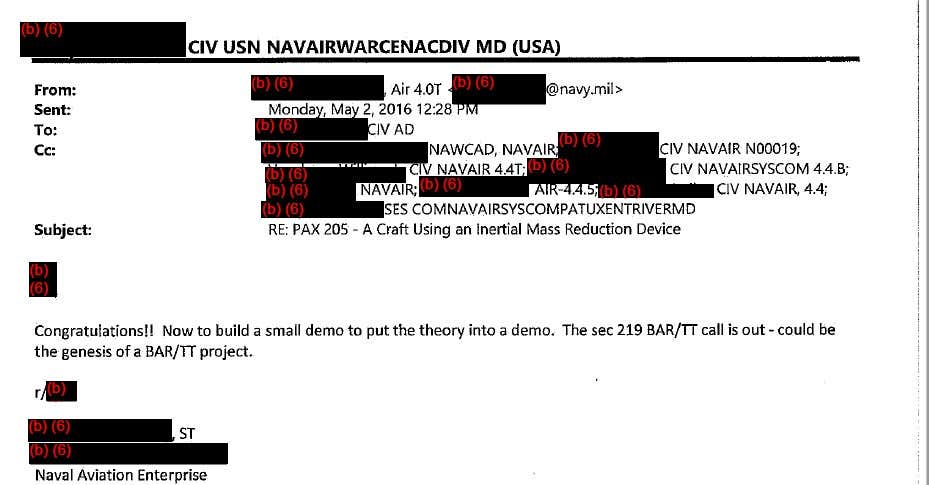
Funding for the proposed Section 219 BAR/TT project mentioned in this email appears to have ultimately been granted, as Pais cites the funding his work received from it a year later in 2017 in two academic publications for radical new propulsion concepts, and again in 2019 for a "Hybrid Aerospace-Undersea Craft."

Another statement made by NAWCAD leadership appears to suggest that demonstrative experiments were designed to test the "Pais Effect" as a result of this 219 BAR/TT project. In 2017, Dr. Sheehy, the Chief Technology Officer for the Naval Aviation Enterprise, wrote to the USPTO to declare that Pais was “currently funded by NAWCAD to design a test article and instrumentation to demonstrate the experimental feasibility of achieving high electromagnetic (EM) field-energy and flux values.” Sheehy added that Pais was at the time “one year into the project” and had “already begun a series of experiments to design and demonstrate advanced High energy Density/High Power propulsion systems.”
According to a U.S. Navy fact sheet, Section 219 of the Fiscal Year 2009 National Defense Authorization Act, which had been amended since then, "established a mechanism whereby a defense laboratory may fund basic and applied research, transition of technologies developed by the defense laboratory into operational use, recruitment and retention of personnel with needed scientific and engineering expertise, and revitalization and recapitalization of the laboratories. Basic research is directed toward greater knowledge of the fundamental aspects of phenomena and of observable facts without specific applications towards processes or products in mind. Applied research is understanding the means to meet a recognized and specific need. It may be oriented toward the design and development of prototypes." The same sheet adds that "technology transition moves mature technologies into programs of record."
In the emails related to the high-temperature superconductor patent application (PA), an individual with a “Navy.mil” email address suggests trying to get a phone interview with a primary examiner, noting that “we can defend this PA very well.”
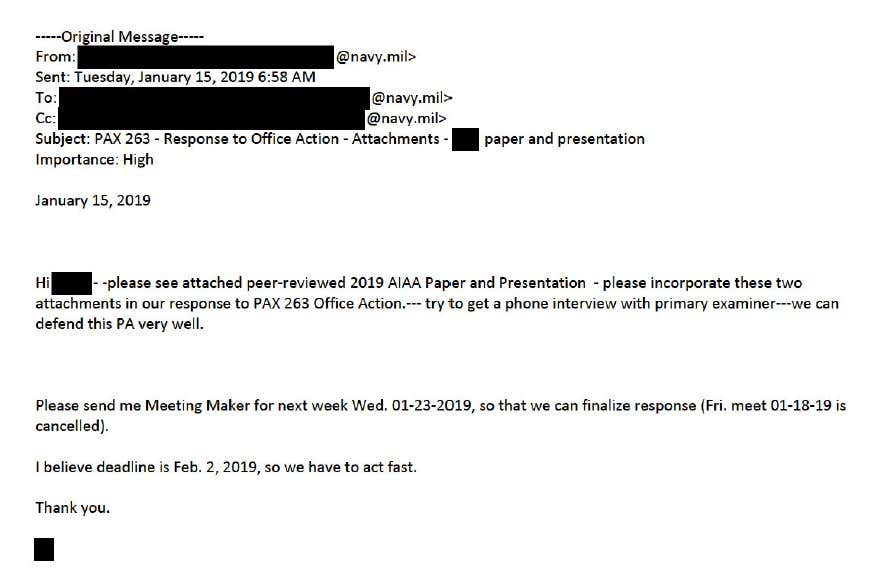
Based on documents found in the USPTO Public Pair website related to the high-temperature superconductor patent application, we know a telephone interview between Pais, NAWCAD patent attorney Mark Glut, the primary patent examiner, and another USPTO examiner took place on June 6, 2019. In that interview, Pais argued that the theoretical basis for the high-temperature superconductor is sound despite a lack of experimental evidence.
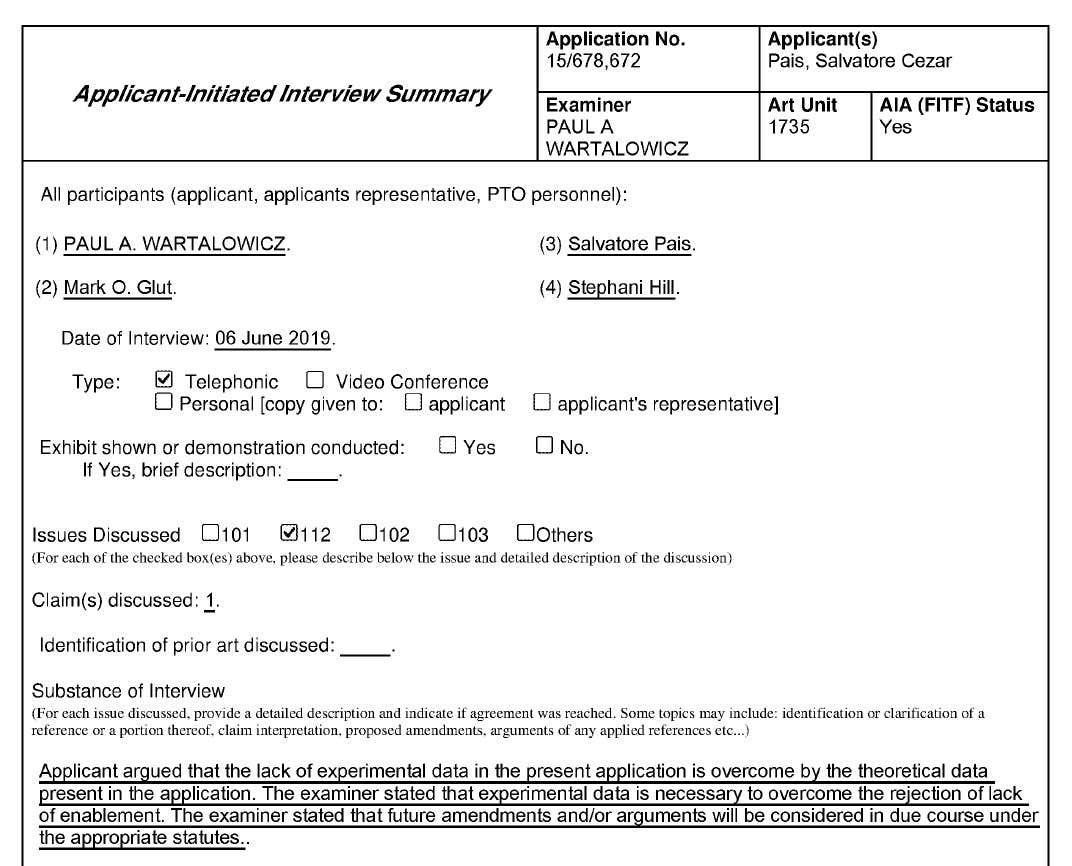
The emails concerning the high-temperature superconductor show that Pais was turned down by energy research journal Joule in 2017. Joule editors wrote that “while the topic of room temperature superconductivity is of course very exciting, we would require you to provide some compelling experimental validation of your proposed theoretical pathway before we could reconsider.” However, Pais’ paper “Room Temperature Superconducting System for use on a Hybrid Aerospace-Undersea Craft” was published in the proceedings of the AIAA SciTech forum in 2019. That paper contains no experimental data.

The application for the high-temperature superconductor remains pending at the time of publication.
Recent Scientific Breakthroughs And The Pais Patents
In recent months, several major developments have made waves throughout the scientific community that reportedly achieve what Pais's patents claim to. A radical breakthrough marking what researchers call the first room-temperature superconductor was announced in Nature in mid-October, potentially opening the door to new methods and levels of power generation. Despite the excitement, achieving this type of superconductivity requires extreme pressures, the lowest of which was 2.6 million times the atmospheric pressure at sea level. For now, the world’s first room-temperature superconductor will remain in laboratories at minuscule scales.
Last month, another radical high-temperature superconductor design was revealed to the world. Researchers at the Massachusetts Institute of Technology (MIT) and its spin-off firm Commonwealth Fusion Systems (CFS) published seven articles in a special edition the Journal of Plasma Physics detailing a revolutionary new compact fusion reactor design. MIT/CFS claims that the reactor, known as SPARC, could very well be “the first net-energy controlled fusion experiment” in the world.
According to MIT’s Martin Greenwald, Deputy Director of the MIT Plasma Science and Fusion Center and lead scientist on the SPARC project, one of the key technologies leveraged in the SPARC design is “a newer electromagnet technology that uses so-called high temperature superconductors (HTS) that can produce a much higher magnetic field” to contain the fusion reaction within.

Concept art for the SPARC reactor.
While these recent developments in HTS technology appear unrelated to the physical mechanisms claimed to enable the “Pais Effect,” they certainly show that mysterious inventors working behind closed doors in Department of Defense labs aren’t the only ones pursuing these “Holy Grail” technologies.
As Always, Questions Remain
While these internal NAVAIR emails may not alleviate the mystery surrounding the peculiar inventions of Dr. Salvatore Pais and the reasons why NAVAIR leadership vouched for their operability to the USPTO, they do add details about the inventor's patent application process and the internal reviews that the patents underwent.
Aside from adding to our understanding that Pais has consistently vouched for the patents being both incredibly revolutionary and possible to engineer with current methods and materials, these emails reveal that numerous employees of NAWCAD and the Pax River Invention Evaluation Board took them seriously enough to clear Pais’s patents for the USPTO application process.
We also now know these inventions resulted in the Section 219 Basic Applied Research/Technology Transfer program that was successfully funded and resulted in a physical demonstration and further experimental testing. We also now know the inventions underwent the aforementioned technical and marketing reviews by the award-winning NAWCAD Technology Transfer Office, which, in part, facilitates technology transfer to partners outside the Navy, before the patents were applied for.
Despite these new details, we are just as mystified as ever by these bizarre patents and what they might mean for the “technologically advanced future of the Navy.” We have yet to find any experimental validation or subject matter experts who can confirm Pais's theories.
Regardless, The War Zone continues to pursue multiple FOIA requests related to these patents and the research projects that led to them.
The FOIA releases can be read in their entirety below. Special thanks to reader Michael E. Boyd for providing The War Zone with this FOIA release.